
Saigon, from the Mekong River
Published in International Travel News, April 2009, http://www.intltravelnews.com/
“This is a river that could keep us busy for years,” uttered my husband, Steve, who has a fascination with rivers. Our first trip to Vietnam this summer began our exploration of the Mekong River that will span many trips to come as we unlock the secrets of this undulating waterway that moves through China, Burma, Thailand, Laos, and Cambodia. Scouring the lands of many dialects, the river brings both opportunity and destruction at its terminus in Vietnam, more than 2,000 miles from its headwaters in the Tibetan plateau. From the trickle of 17,000 foot snow-capped mountains, through thundering gorges and broad, liquid highways, the Mekong River exhausts itself in the nine tributaries that make up the Mekong Delta before emptying its caramel colored waters into the South China Sea. Opportunities abound in the nutrient-rich flat-lands of the Mekong Delta that produce an abundance of crops, but the rainy seasons regularly generate uncontrollable floods that claim lives and disrupt commerce.
SAIGON
Arriving in the bustling metropolis of Ho Chi Minh City, still known as Saigon to the locals, we set off seeking Kim Travel (270 De Tham, 08/836-9859, www.kimtravel.com), noted in the guidebook to have long-standing experience in setting up independent tours in the Mekong Delta. We chose a 3 day, 2 night tour (US$106 for 2; included mini-hotel with air conditioner (AC), boat trips, AC bus, English-speaking guide and entrance fees) which seemed an excellent value.

Steve, enjoying a bowl of soup
That settled, we picked up a few things from the bustling open air market, enjoyed bowls of noodles with savory chunks of pork and giant, sweet steamed prawns, and threaded through nightmarish traffic to the hotel. We pared down our three day-packs to two small day-packs, leaving the largest at the hotel. We congratulated ourselves many times over the next few days as we clambered from unsteady docks to small water craft to vans with limited baggage space, watching others labor under giant duffel bags or huge wheelies.
SAIGON RIVER

One of many street vendors
Early the next morning, after Steve bought a freshly fried, crisp donut from a street vendor, we chugged up the Saigon River on a motor boat, merging eventually with the Mekong River. The three hour trip passed quickly as life on the river unfolded before us, first reflecting industrious city life with many motor boats, ships and densely clustered shanties built over the river on stilts. Giving way to residential areas, laundry was hung out to dry over the river, children splashed in the muddy, milk-chocolate waters, adults bathed and the rhythms of daily life stretched through the morning. Part way through our journey we stopped for fuel at a riverside gas station. The captain grabbed the hose, squatted on the deck while filling the tank and casually lit a cigarette. I waited patiently for the explosion but events proceeded uneventfully and we were on our way.
MY THO

Snake Wine
Three hours later we disembarked in My Tho, where we transferred to a smaller boat to traverse the narrow channels to Ben Tre, a low-lying rice bowl of the Mekong. A network of tributaries and canals laces this province, only accessible by boat. We threaded our way down a slim path and made a few stops to observe some unusual sights. After observing and handling honey bees and boa constrictors we sipped lemon tea made from tiny lemons, munched on snacks and sampled rice wine and snake wine—the latter a bit earthy for my taste, not mention unnerving to view the glass jar crammed with a long, coiled snake. Steve bought packages of peanut snacks and dried ginger to tide him over during those rare times when a street vendor wasn’t available.
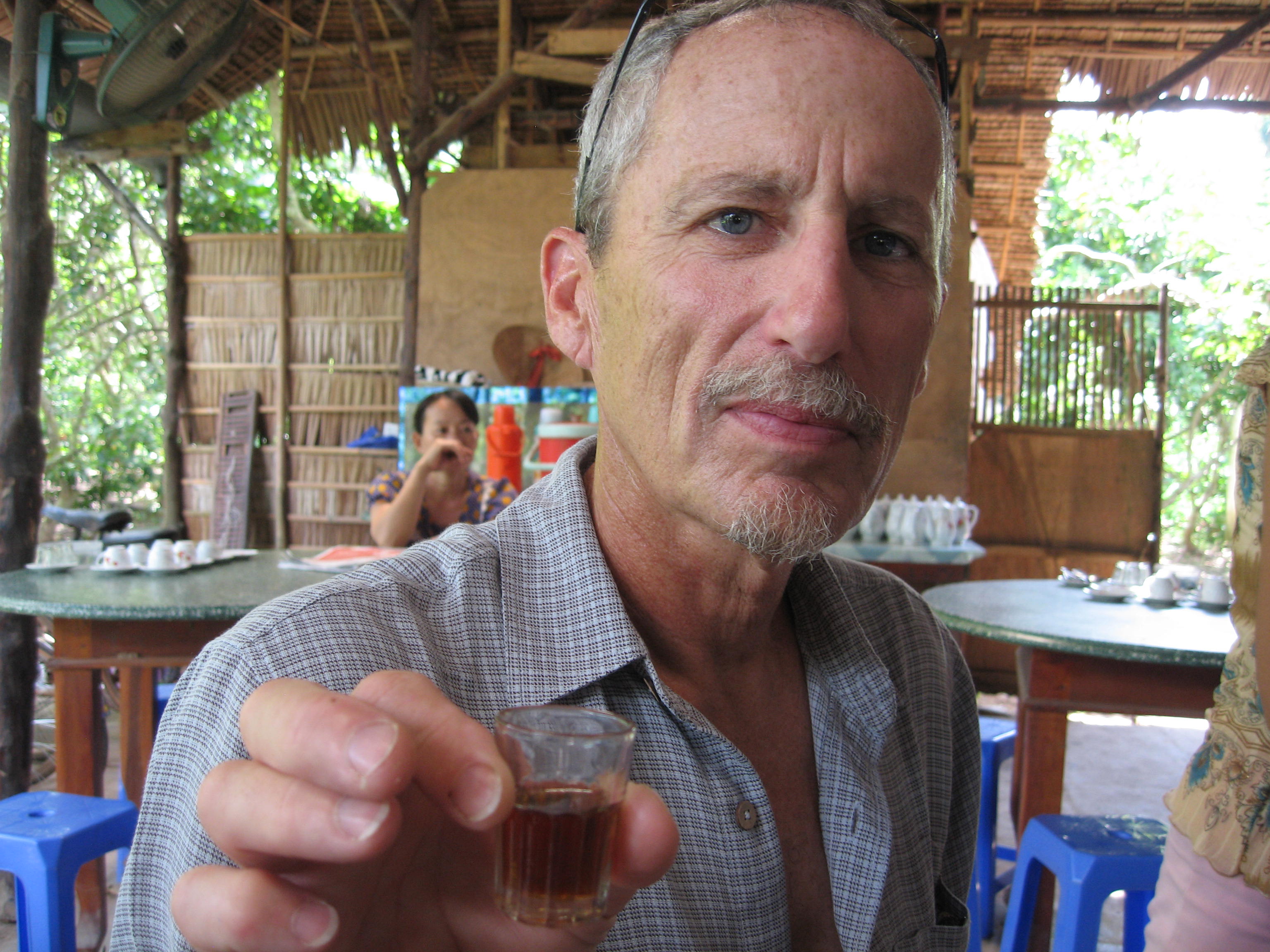
Steve enjoying a little nip of snake wine
We continued down the path to taste a variety of tropical fruits, enjoying sweet papaya, pineapple, pomelo, and sapodilla, a soft orange fruit with the consistency of a nectarine. This was our first exposure to “longan”, a lychee-like fruit that looks like an eyeball after peeling. We enjoyed the clear, delicately sweet flesh and subsequently ate them by the kilo.
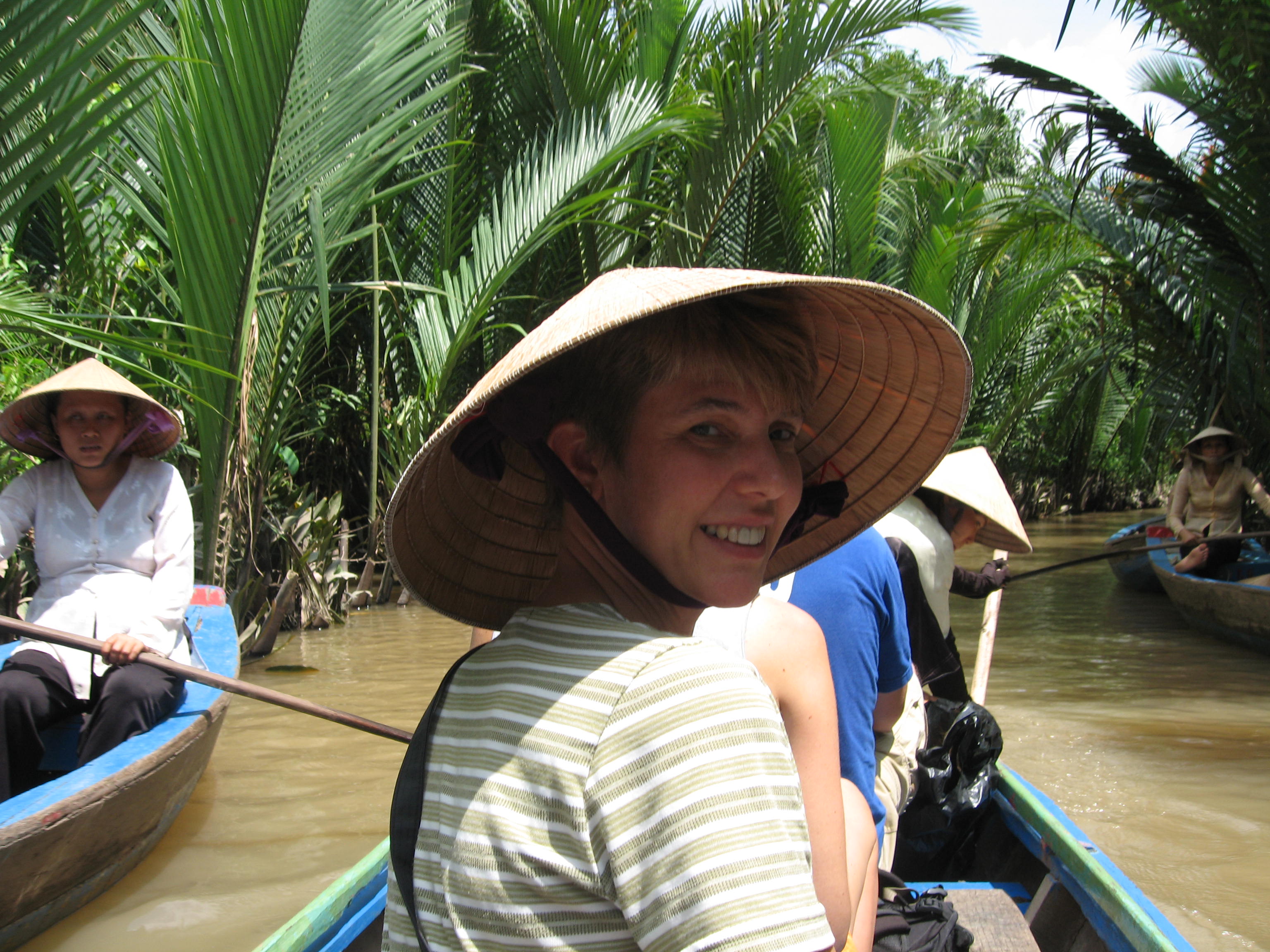
Inga on the Mekong River
We were then ushered onto small wooden canoes piloted by women using long, flat oars to propel us through narrow, intertwined canals thickly lined with tropical foliage. It was quiet and peaceful listening to the plop and gurgle of the poles plunging into the water, and perhaps a bit eerie as my memory flashed to images from the movie, Apocalypse Now.

Women making coconut candy
Our next stop at a coconut candy-making operation was, perhaps surprisingly, fascinating. We appreciated the many steps required to turn coconut into candy, starting with grinding and pressing the raw coconut meat, then mixing it into a thick paste. After rolling the paste into a form to let it harden it is cut into small pieces like dominoes, wrapped with edible rice paper and packaged. Steve, ever the “coco” lover, was hooked and bought a large enough supply to last long after the trip was over. We added this to our growing supply of snacks.
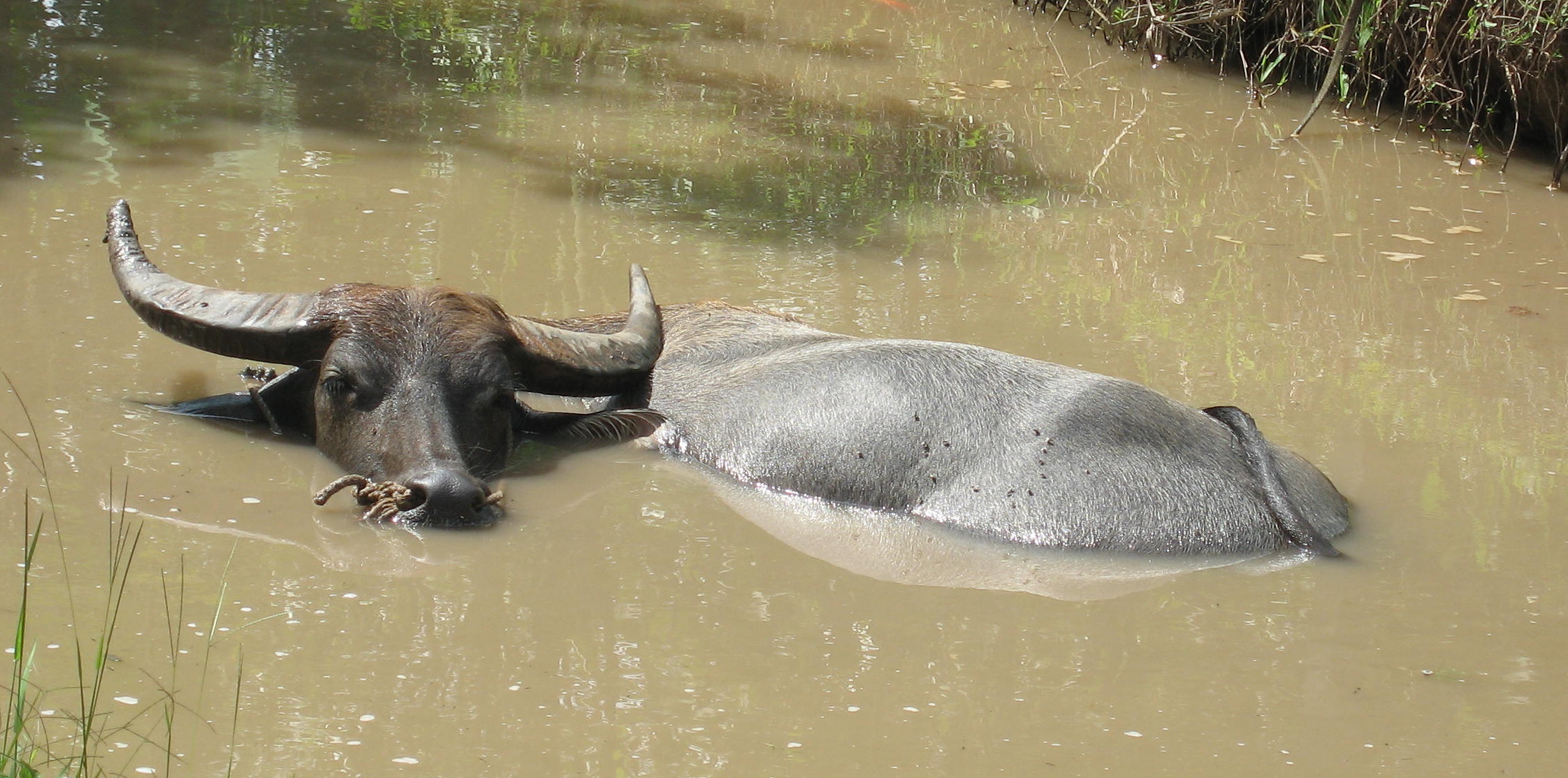
Water buffalo
Yet another boat ride delivered us to lunch on the banks of interlacing canals, where we dined under the watchful gaze of a water buffalo wallowing contentedly in the muddy waters. We ate a simple meal of fried rice and young coconut, followed by a snooze in hammocks strung under the banana trees, eschewing the option of bicycling to a nearby village in the blistering noonday sun.
CAN THO
A three hour drive in a comfortable van put us in Can Tho after dark. Our mini-hotel (Xuan Mai Mini Hotel, 17 Dien Bien Phu St, Can Tho, Tel: 071.823578-814152) was definitely mini, but was equipped with a window, comfortable bed, cable TV and AC in rather Spartan conditions. On the main street we found some uninspired Chinese food to fill our bellies and fell exhausted into bed.

Steve, waiting for his next snack
Our wake-up call, a knock on the door at 6:00 AM, stirred us to rise. A small burner in a room behind the front desk turned out fluffy omelets, accompanied by the ubiquitous light, airy French rolls that melt in your mouth. Back at the dock, Steve continued his tour of Mekong street vendors, purchasing a sweet crepe, rolled up for easy nibbling.
FLOATING MARKET AT CAI RANG

Boat playing its wares
A small motorized boat transported us to the floating market at Cai Rang and we delighted in watching local commerce taking place. Boats of all different sizes come to this central meeting place on the river to sell their produce. A tall, slender pole is hoisted at the bow with a sample of the produce available on that boat. Larger boats act as consolidators, displaying a large variety on their pole, the smallest scallions flying on top and the largest gourds anchoring the bottom. A booming floating service market of cafe boats cruised around dishing up local delicacies to the workers.

Who could resist this saleswoman?
After a stop at an open air market, Steve bought a flavorful snack comprised of steamed rice and savory meat wrapped in banana leaf from a man on a motorcycle, which we washed down with the mild juice of a young coconut. After drinking the liquid from a straw a slight woman wielding a hefty hatchet made short work of whacking the coconut in two so we could scoop the custard-like coconut meat with a spoon.
CHAU DOC
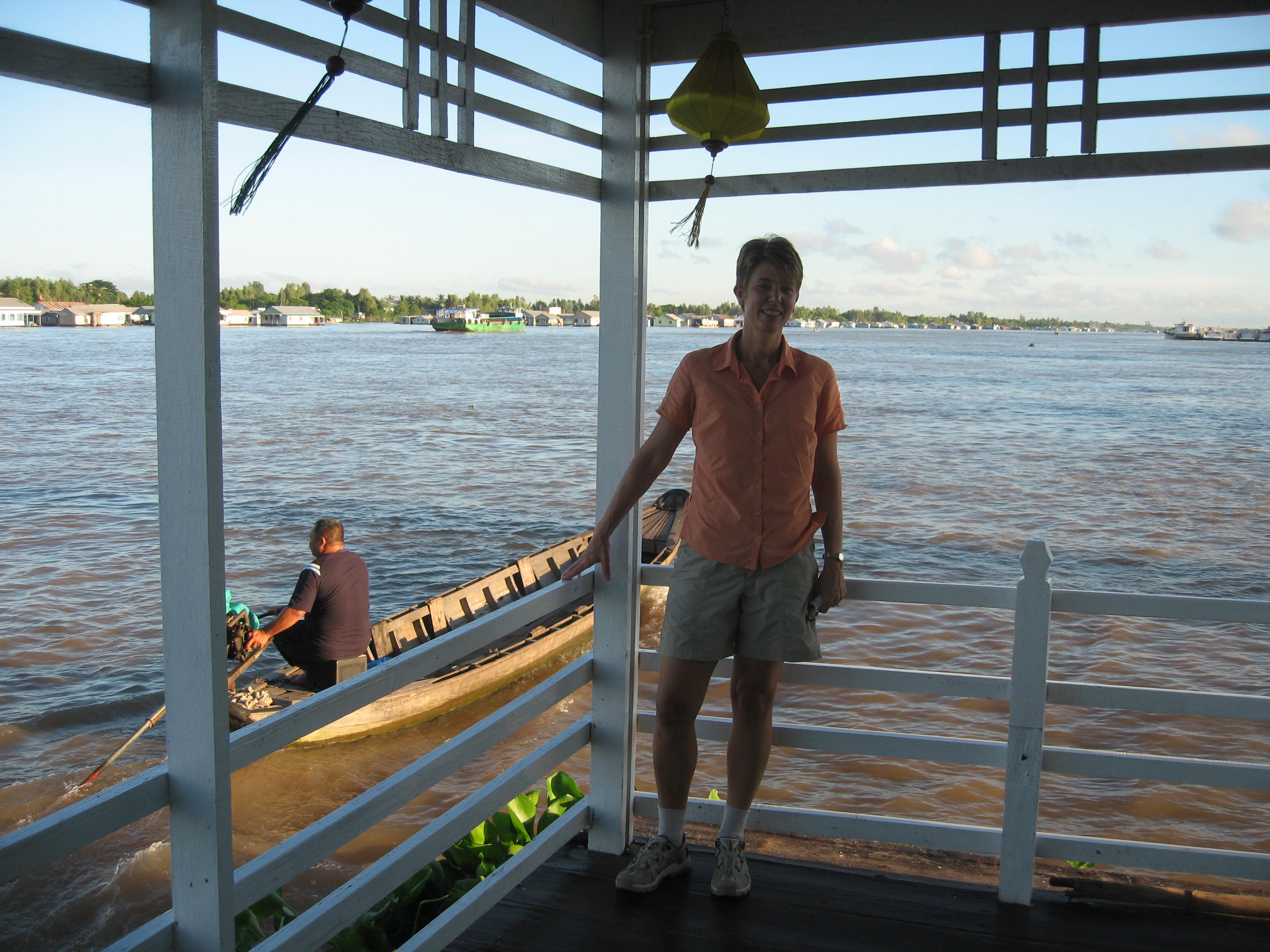
Inga at the floating hotel
Returning to Can Tho, lunch, followed by a stroll around town preceeded a long bus ride to Chau Doc. Steve snacked on longan, coconut candy, dried ginger and other assorted snacks. A power outage in Chau Doc resulted in a murky transfer from van to boat to cross the river to the Delta Floating Hotel. Luckily the beer was still cold and cheers erupted when the generator sputtered to life. The floating hotel was pleasant with a large room, two beds draped with mosquito nets but equipped with only a fan. The fan churned the warm, still air a bit, but I spent a long, hot night entangled in my mosquito net.
CARVEN PAGODA
The morning dawned bright, sunny and hot as we made our way to the Carven Pagoda. Climbing many steps our reward was a panoramic view of the mountains of nearby Cambodia, fronted by brilliant green rice paddies. We were sobered to learn that just beyond the mountains were the infamous Killing Fields, where many ethnic, religious and political minorities lost their lives at the hands of the Khmer Rouge from 1975-1979. That brutality was contrasted by the saint honored at this pagoda, who provided medicines and kind acts for the local people.
Back on the river, a larger boat carried us to a visit to a local houseboat family. The numerous houseboats are spacious with large decks surrounding a watery hole. Our guide grabbed some pellets out of a bag and suddenly the water was transformed as a roiling mass of fish leapt from the water, fighting for the fish food. Each houseboat is fitted with a large net under the house where they raise catfish and other fish, up to 100,000 at a time.
CHAM VILLAGE
We continued down the river, disembarking onto a rickety, narrow boardwalk. We met members of a local Cham village, an Islamic minority community whose ancestors originated in Malay-Polynesia, but who were influenced by ancient Middle Eastern traders who migrated through Tibet in the 2nd century AD to the Mekong. Originally following a form of Hinduism, a Champa king converted to Islam in 1607, and now about 80% of the Cham in Vietnam are Islamic. The Cham people formed an important link in the Spice Route between Southeast Asia and the Persian Gulf.

Cham Woman at her Loom
A Cham woman sat weaving at a large loom producing truly beautiful silk scarves and fabrics in rich, brilliant colors for extremely low prices. We ambled further down the boardwalk, accosted by winsome children selling banana and coconut waffles. Purchasing from one child extracted howls of protest from other children so Steve did what he could to soothe hurt feelings. By now it wouldn’t have surprised me if everyone on the Mekong knew that Steve was a sucker for street snacks.
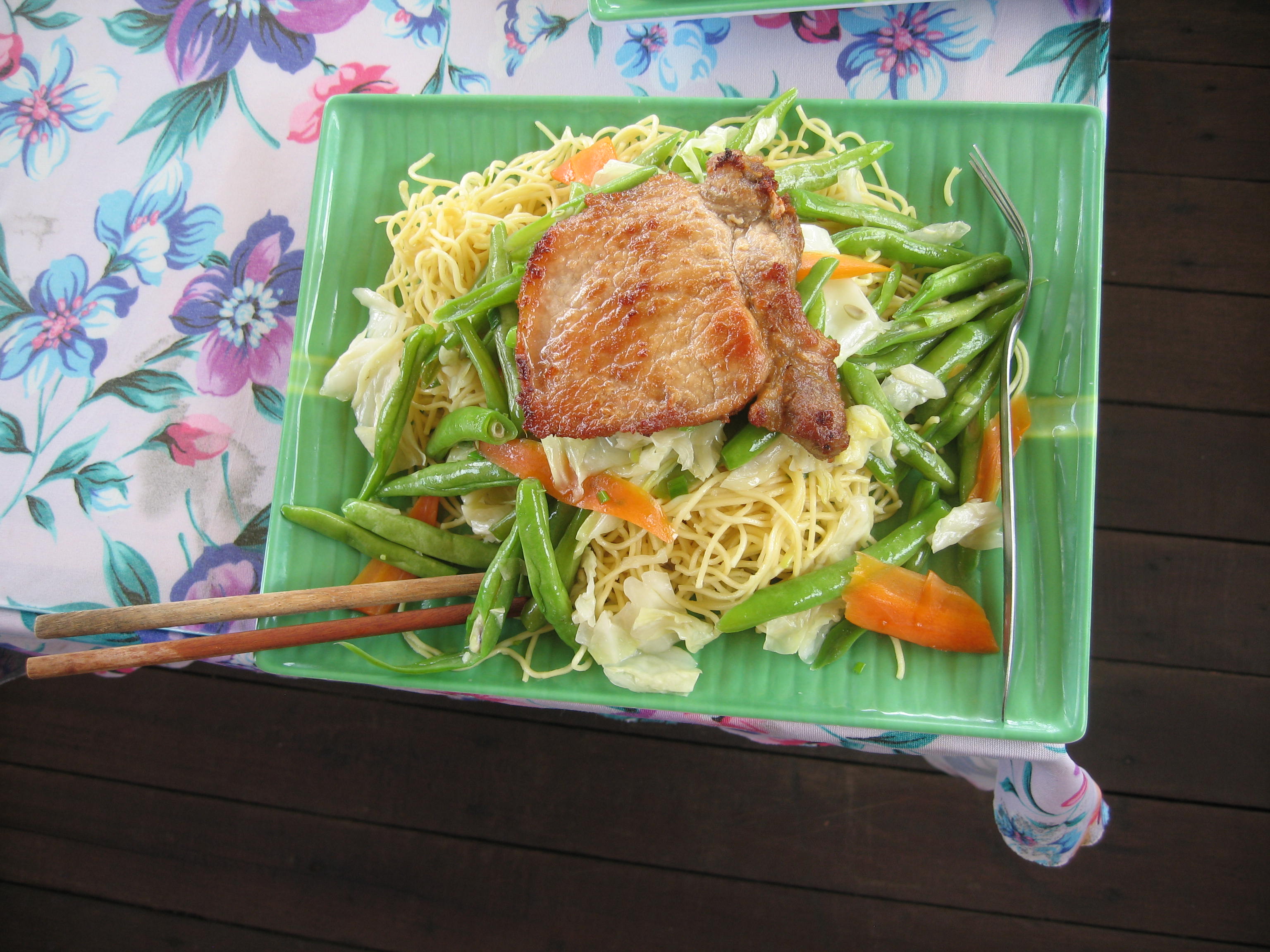 Transferring to a larger boat we stampeded to the upper deck to claim a limited number of deck chairs as we motored further along the river. About five minutes later the deck was cleared, everyone driven below decks by the searing rays of the tropical sun. We were served a delightful lunch of stir fried noodles and savory fried pork. Our most unique disembarkation consisted of descending from the boat into a field at Long Xuyen thickly populated with tall weeds. This was easily accomplished with our small daypacks, but caused some amused consternation for those with large wheelie suitcases.
Transferring to a larger boat we stampeded to the upper deck to claim a limited number of deck chairs as we motored further along the river. About five minutes later the deck was cleared, everyone driven below decks by the searing rays of the tropical sun. We were served a delightful lunch of stir fried noodles and savory fried pork. Our most unique disembarkation consisted of descending from the boat into a field at Long Xuyen thickly populated with tall weeds. This was easily accomplished with our small daypacks, but caused some amused consternation for those with large wheelie suitcases.
RETURN TO SAIGON
A long bus ride delivered us back to Saigon by early evening. Along the way we saw many farms raising ducks, rice, and vegetables. Some of my favorite sights were large, open air restaurants situated along the roadsides with hammocks strung beside each table. We were enchanted by lissome women in elegant, white, flowing au-dais (a snug fitting tunic worn over loose pants) sitting perfectly erect on their one-speed bicycles. We wondered how they stayed so spotless when we looked crumpled and damp after standing outside for two minutes. A rest stop allowed Steve another opportunity for a banana-leaf wrapped snack, this one filled with fluffy white rice and shredded, fresh coconut sprinkled with sugar. It was a simple and surprisingly tasty treat.
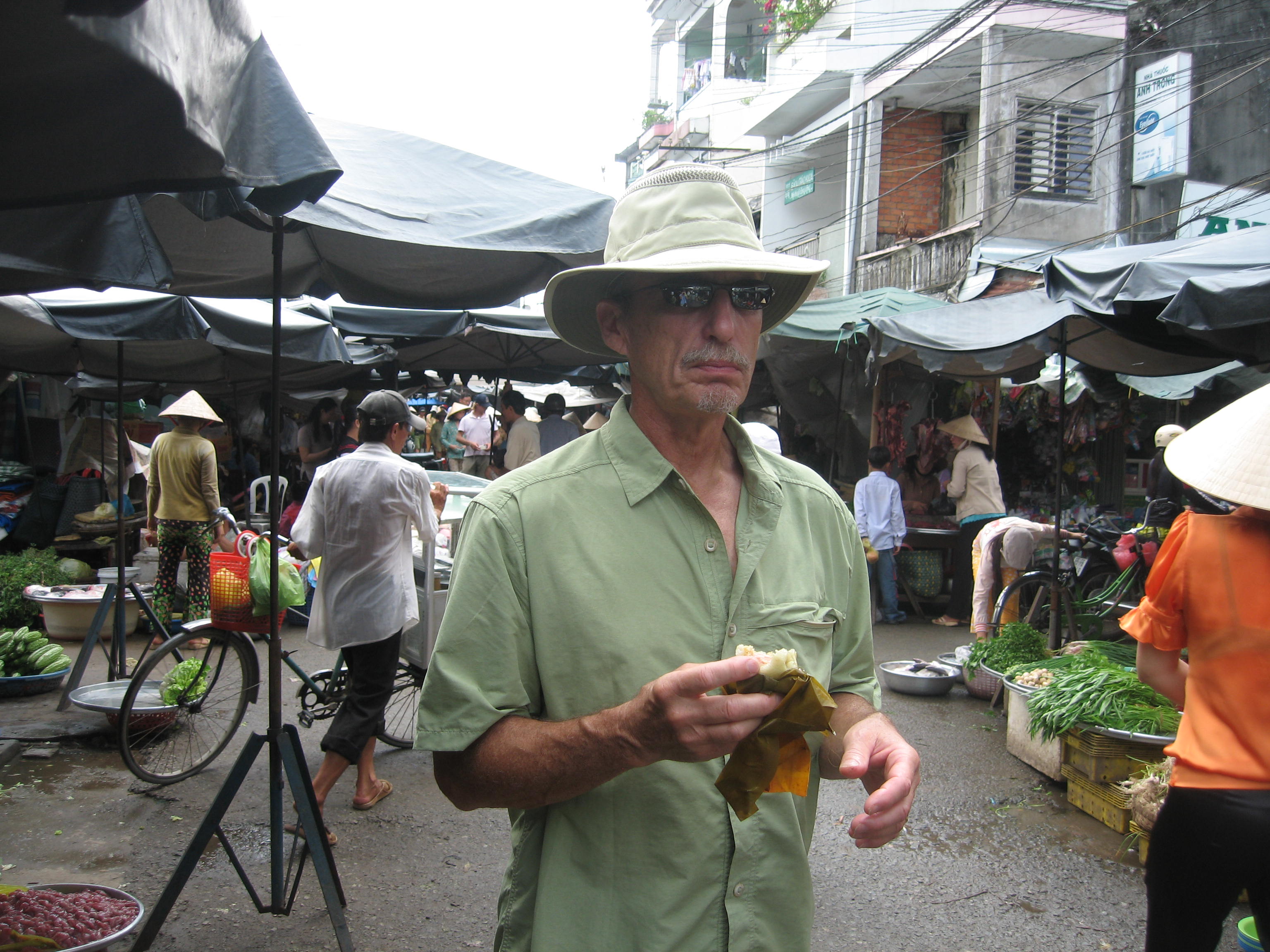
Steve, eating…again
As we reflected back on our three captivating days on the river, we laughed at our memories of Steve eating through the street vendors of the Delta, and remembered the smiling faces of the many children we encountered, and the generous people who graciously shared a slice of the delta lifestyle with us. We were impressed with our knowledgeable guides and the efficient coordination of so many different boats and vehicles that that transported us that we lost count. This provided a wonderful opening chapter to our future exploration of the mighty Mekong.
Information:
Kim Travel
270 De Tham
Ho Chi Minh City, Vietnam
Phone: 08/836-9859
www.kimtravel.com